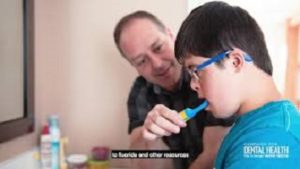AAPD Policy on the Use of Silver Diamine Fluoride for Pediatric Dental Patients
Guest Blog Post by Yasmi O. Crystal DMD, MSc, FAAPD
Clinical Associate Professor of Pediatric Dentistry
NYU College of Dentistry
When very young children or children with special needs have cavities, placing fillings in their teeth can be a challenge for all involved. These children often need to be sedated or put to sleep with general anesthesia, which increases both the risk and the cost of the treatment. But now there is a new alternative: Silver Diamine Fluoride (SDF). SDF is a clear antimicrobial liquid that is painlessly “painted” on the cavities. As the silver compound kills the cavity-causing bacteria, and the fluoride hardens the remaining tooth, SDF temporarily stops the cavities from growing. (This is referred to as “caries arrest”.) This therapy is safe, affordable, and reduces trauma and risk.
SDF was approved by the Food and Drug Administration (FDA) in 2015 for the treatment of sensitive teeth in adults. Worldwide, studies now show the efficacy and safety of SDF for caries arrest in children. The American Academy of Pediatric Dentistry (AAPD) has recently published the Policy on the Use of Silver Diamine Fluoride for Pediatric Dental Patients as part of a comprehensive program for the management and treatment of tooth decay in children.
SDF is not without some drawbacks. Cavities treated with SDF turn permanently dark and, depending on the location of the treated tooth, this can be visible. (As children get older and circumstances change, these teeth can be given traditional fillings to improve esthetics or to address issues such as food becoming trapped.) Children with silver allergies, and those with cavities that reach the nerve, are not good candidates for this therapy. Since about 20-30% of cavities do not respond to a single application, children treated with SDF need to be periodically monitored. To have a sustained effect, SDF needs to be applied at least twice a year.
The Campaign for Dental Health advocates for prevention in all forms, whether it be community water fluoridation, fluoride varnish in the pediatric office, or school-based sealant programs. The adoption of an SDF policy by the AAPD to help reduce the severity of existing disease, especially for kids who need it most, is a welcome step towards reducing the incidence of dental caries in young children.

